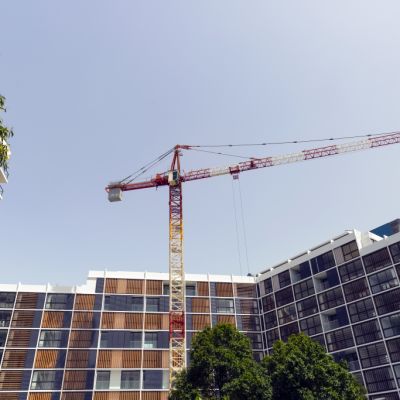Governments need to care more about renters and defer less to wealthy home owners, think tank says

Governments need to care more about renters and young home buyers and defer less to older, wealthier home owners who fear change and block new housing supply in their neighbourhoods, one of the country’s top economists said.
Australia’s housing affordability crisis has been caused by planning restrictions that pander to NIMBYs (Not In My Backyard), blocking new housing construction, the chief economist at conservative think tank Centre for Independent Studies, Peter Tulip, told Domain.
Building more homes in popular inner-city suburbs where housing is most needed was a better way to respond to Australia’s housing crisis than scrapping the often-debated capital gains tax discount and negative gearing, Mr Tulip wrote in a submission to the federal government’s inquiry into housing affordability and supply.
He cited research that these tax settings increased prices only between one to four per cent.
Redirecting federal grants and schemes for first-home buyers to state and local governments to build more homes – on the condition that more infrastructure was also built – was a better way to spend money to increase supply rather than demand, he suggested, as boosting the latter only drove up property prices.
“We need to care more about renters and young home buyers and defer less to wealthy home owners’ fear of change,” he writes. “That may require a national conversation led by the federal government.”
Unless more housing was built, working-class families would not be able to afford their own homes in Australia, Mr Tulip said.
“Our nurses, policemen, shop assistants are being consigned to the outskirts where there is a two or three-hour commute to work, and that is a result of these demand-side policies that are helping some groups and just pushes up prices for non-favoured groups,” Mr Tulip said in an interview.
 Australia’s housing market boom ranked seventh in the world: Knight Frank report
Australia’s housing market boom ranked seventh in the world: Knight Frank report Increased housing supply is dependent on profitability of developments: AHURI
Increased housing supply is dependent on profitability of developments: AHURI Bank of Mum and Dad ‘prolific’: Now helping adult children on their second homes
Bank of Mum and Dad ‘prolific’: Now helping adult children on their second homes Australian house prices could rise 10 times as fast as wages in 2021
Australian house prices could rise 10 times as fast as wages in 2021 House price to income ratio continues to climb amid property boom and low wage growth
House price to income ratio continues to climb amid property boom and low wage growth
“There is a huge problem that working-class families can’t afford to live within commuting distance of the city.
“Have more respect for the people struggling in the housing market and be less deferential to wealthy old NIMBYs.
“NIMBYism is the cause of the housing crisis in Australia.”
He said current planning restrictions were driven by older, wealthy home owners afraid of any change in their neighbourhoods, benefiting from this as the value of their houses continued to rise due to scarcity while hurting those who do not own a home.
“There is a big distributional issue … planning restrictions are good for the wealthy and bad for young people and bad for poor people.”
More housing construction would ultimately mean more apartments. That would change the face of our neighbourhoods, something that citizens needed to confront in the bid to make housing more affordable for all, he said.
“We need more high rise apartments, but the character of our cities is changing anyway,” Mr Tulip said. “You don’t preserve the character of a neighbourhood by stopping building. You make it more wealthy and more exclusionary.
“Our cities have to change. The question is, in what way do they change? Do we have more buildings? Or do we have more inequality among younger Australians and renters?”
Mr Tulip argued in the think tank’s submission to the inquiry into housing that immigration was the most significant way in which the federal government affects the housing market. Yet, there was an “imbalance in government incentives” that helped state and local governments pay for extra infrastructure required to accommodate the growing population.
Although immigration and overall population growth were driving the long-run demand for housing, he said low interest rates drove the latest boom. Immigration has slowed to near zero in the pandemic, while house prices have soared.
The submission recommends an increase in housing supply as a way to create substantial and widespread improvement in housing affordability.
He calls for the federal government to consider constructing performance benchmarks for state and local governments. Measurement of excess demand could guide the allocation of grants and guide planning decisions.
For example, he said the federal government could allocate more funding to the states and local councils that build more housing. In the UK, a grant is paid to local authorities that deliver housing above set benchmarks, while in the US, grants are proposed for local governments that ease planning rules.
Or tie infrastructure spending to housing outcomes, as a lack of infrastructure is a common reason for withholding planning approval. Grants could be allocated on the basis of population growth instead of the actual population.
Residents’ groups and councils often cite impacts on local infrastructure – such as crowded roads, public transport and parks – as reasons to oppose development, he said.
“Planning restrictions mean that Australians pay too much for their housing,” Mr Tulip wrote.
“Solving this problem essentially involves getting state and local governments to stop saying no and start saying yes. Making federal expenditure on infrastructure conditional on housing reform may help to deliver
more affordable housing.”
We recommend
We thought you might like
States
Capital Cities
Capital Cities - Rentals
Popular Areas
Allhomes
More
- © 2025, CoStar Group Inc.







